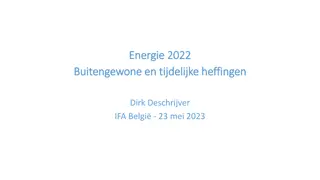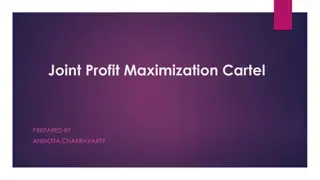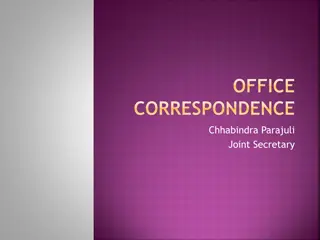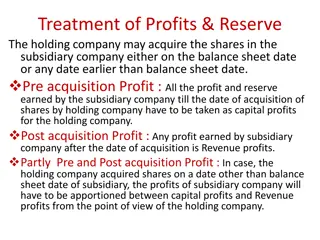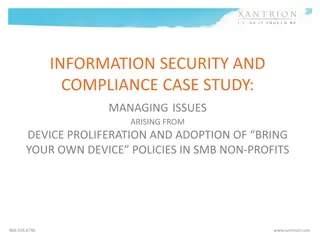Maximizing Profits and Managing Risks with Engagement Letters
Enhance your firm's risk management strategies and fee structures by leveraging engagement letters effectively. Learn how to handle additional work, prevent disputes, and optimize client relationships with clear policies and clauses. Find out ways to transform high-risk, unprofitable clients into low-risk, profitable ones through smart engagement practices. Stay ahead of potential issues by reviewing engagement letters regularly and utilizing ad hoc services wisely.
Download Presentation

Please find below an Image/Link to download the presentation.
The content on the website is provided AS IS for your information and personal use only. It may not be sold, licensed, or shared on other websites without obtaining consent from the author.If you encounter any issues during the download, it is possible that the publisher has removed the file from their server.
You are allowed to download the files provided on this website for personal or commercial use, subject to the condition that they are used lawfully. All files are the property of their respective owners.
The content on the website is provided AS IS for your information and personal use only. It may not be sold, licensed, or shared on other websites without obtaining consent from the author.
E N D
Presentation Transcript
Engagement Letters- how to use them to manage risk and increase fees For the RiskBites Club 10 October 2022 kareneckstein.co.uk
Engagement Letters- how to mange risk and increase fees Additional work When to review Ad hoc (agreed further services) clauses and policies Spot the consumer and stay out of trouble! Train your client-reduce risk and increase fees Protections in the engagement letter for you and your client Liability caps Preventing problems with your insurer- what to say about your insurance in your engagement letter. kareneckstein.co.uk
Additional work When to review engagement letters generally Annual reviews or more often? Fee alerts? Additional work outside the retainer How to turn a high risk unprofitable client into a low risk profitable one How to identify when work falls outside the agreed retainer What to do when work falls outside the agreed retainer Use of an ad hoc (agreed further services) clause What to put in the ad hoc policy kareneckstein.co.uk
How to turn a high risk, unprofitable client into a low risk profitable one (1) How does it happen? The client that asks a quick question The client that wants advice on a new direction or business decision The client that has a tax investigation letter The corporate client that wants personal tax work The client that wants a quick valuation for the bank Lots of additional work carried out, outside the retainer You may not be able to charge fees for that work, especially if you have quoted a fixed fee for your retainer The protections in your engagement letter may not apply kareneckstein.co.uk
How to turn a high risk, unprofitable client into a low risk profitable one (2) Use of an ad hoc or agreed further services clause in the engagement letter enables you to deal with these additional queries (if you want to) under your engagement letter You need to be able to know that the queries are outside the terms of the agreed retainer Who knows the terms of the retainer? What you have agreed to do, not do, when by, for whom and why and who has authority to give instructions? Use of an alert when the file is opened? So that all staff working on the file know? kareneckstein.co.uk
How to turn a high risk, unprofitable client into a low risk profitable one (3) What to do? When a client asks that quick question- confirm that the question falls outside the retainer, but that it can be dealt with under the ad hoc clause Ask the client if they are happy for it to be dealt with under the clause, when they agree, confirm the facts, purpose and advice and that it is given under the clause as agreed (confirm who can rely on it if appropriate) This can be by phone, but then confirmed in writing by email This will then enable you to benefit from the protections in the engagement letter and to charge for the work done You have then minimised the risk and increased your fees kareneckstein.co.uk
The ad hoc policy The policy will need to confirm the process to be followed i.e. that staff need to check if there is an ad hoc clause in the engagement letter They need to agree with the client that the ad hoc clause will apply, this enables them to act and charge fees The policy should advise staff to confirm in writing (email is fine) that they have so agreed The policy should advise staff to confirm in writing (email is fine) the facts, the purpose and the advice given and, if appropriate, who can rely on the advice The policy should confirm how much work can be done (3 hours? 1 hour?) before a new engagement letter or schedule of services is needed The policy should confirm what sort of work should not be undertaken e.g. valuations kareneckstein.co.uk
Consumers (1) Spot the consumer to stay out of trouble! Why does it matter? Consumer Contracts (Information Cancellation and Additional Charges) Regulations 2013 apply to contracts post 13.6.2014 Any contract with a consumer is either an off premises contract, a distance contract or an on premises contract. For contracts other than on premises contracts, consumers have to be sent relevant information including a right to cancel (14 days). You can also send a start work now form if you want to start work in the 14 day period and not be at risk of losing fees in that period. Prescribed form for the right to cancel Can be a criminal offence not to send the form If the form isn t sent, it can be difficult to recover fees. kareneckstein.co.uk
Consumers (2) When does it typically arise (failure to spot consumers)? Act for a company and do director tax returns Act for an individual in business affairs and start to do personal work What to do and how to do it When you do new work for existing client, have a questionnaire at matter level Is this client an individual? Am I acting for him/her in relation to their personal affairs? If so, he/she is a consumer If so, is the contract an on premises contract or not? If it is not on premises, send the notice! How to increase your chances of compliance and recovering fees Bear in mind the need to think about this when doing ad hoc work- if the client is a company and the ad hoc question is for the client in a personal capacity, then a new engagement letter will be required, no matter how small the task! kareneckstein.co.uk
Train your client to reduce risk and increase fees Late supply of information causing bunching of work Causes you/your staff to work late/under pressure and make mistakes Not just for that client Incorrect supply of information causing need to correct Who corrects it and at what cost? What assumptions are made and what if they are wrong? What delays are caused? And who is liable? How to deal with these aspects Provisions in the engagement letter including discount and penalty pricing and clarity over consequences kareneckstein.co.uk
Protections in the engagement letter for you and your client Dispute within a client/Inconsistency in information Failure to give instructions Errors in returns-PCRT ADR and complaints processes What will you do and what will you not do? What is the purpose of your retainer? Oral advice not to be relied on Delays in relying on advice [process]- confirm facts, purpose and then advice- gives client chance to correct. kareneckstein.co.uk
Liability caps (1) Do you need a cap? Where to disclose the cap? Can it be negotiated? we have discussed and agreed - have you? Is there a file note? Factors taken into account Is a multiple of fee relevant or appropriate? Don t refer to the amount of your pii! Process for setting the cap If you get it wrong, and go too low, then it is struck out entirely meaning you face unlimited liability kareneckstein.co.uk
Liability caps (2) Making the cap a selling point instead of saying if we get it wrong, we are limiting our liability to 5x our [low] fee , you could say .. we want to provide an excellent service, but if we get it wrong, we propose a liability cap of x [high enough] which we consider adequately covers the risks and losses you might face and takes into account all other relevant factors [paraphrased] The impact is very different, the cap is more likely to be upheld, and the relationship with the client gets off to a better start! kareneckstein.co.uk
Preventing problems with your insurer (1) What information about your policy should you put in your engagement letter? Don t forget that the engagement letter will be dated on day one, your cover will apply to the date the claim is made. Those could be in different years. So, the insurer and cover amounts may be different! Don t disclose the amount of cover! (see next slide) Don t confuse the broker and insurer! It is fine (and sensible) to say details of our insurance are available on request - this is acceptable under the Provision of Services Regulations 2009. kareneckstein.co.uk
Preventing problems with your insurer (2) If asked for more details about cover, your response should be limited to a wording similar to the one below. broker!) of ............. (address). The territorial coverage is worldwide excluding professional business carried out from an office in the USA or Canada, and excludes any action for a claim brought in any court in the USA or Canada. (if that is the cover you have). Our professional indemnity insurer is .............(name of insurer- not Don t confirm the limit of your insurance cover without your insurers express consent. This could prejudice your cover! kareneckstein.co.uk
Engagement Letters- how to use them to manage risk and increase fees Any Questions? Karen Eckstein 07973 627039 kareneckstein.co.uk karen@kareneckstein.co.uk kareneckstein.co.uk




